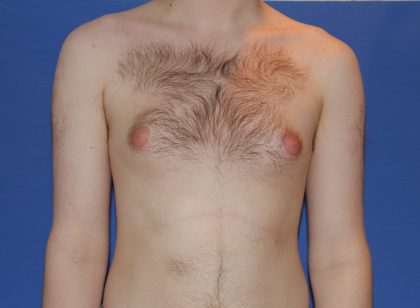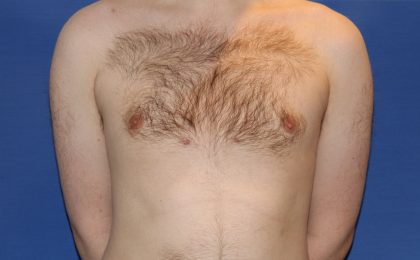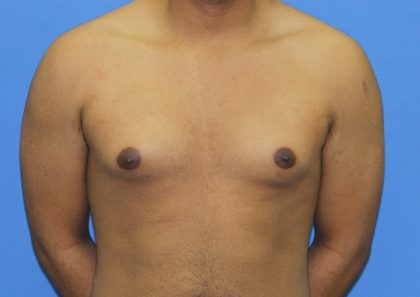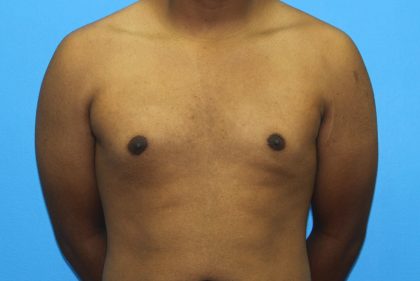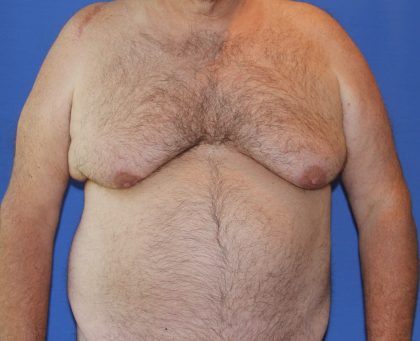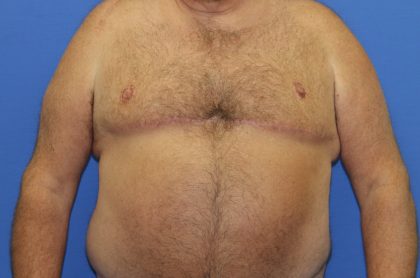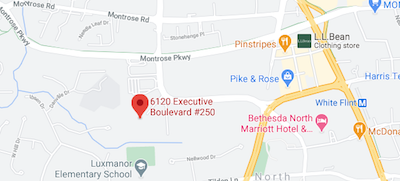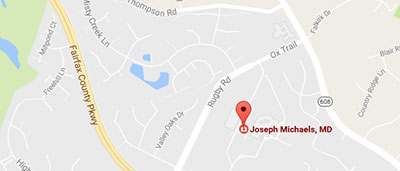
Gynecomastia is a condition in which males grow excess breast tissue as a result of hormonal imbalance. It can be a major burden for men of all ages. Gynecomastia surgery, also known as male chest reshaping, is a surgery that can treat the cosmetic effects of gynecomastia. It can reduce the size of the breasts and provide a masculinized chest for patients.
Before and After Photos
Here at Michaels Aesthetic & Reconstructive Plastic Surgery, we offer expert gynecomastia surgery at our two locations in Rockville, Maryland, and Fairfax, Virginia. Dr. Joseph Michaels is committed to building trusting relationships with his patients and providing life-changing results. For more information, call (301) 468-5991 (Rockville), (703) 957-8610 (Fairfax) or contact us online.
Contents
About Gynecomastia Surgery

Gynecomastia is a common condition in which excess breast tissue grows in males. (1) This can affect males of any age. Men who suffer from gynecomastia often feel self-conscious about their appearance. This can lead to hesitation when engaging in activities that require them to remove their shirt, such as swimming or going to the beach. It can also make men feel uncomfortable during intimacy. At Michaels Aesthetic and Reconstructive Plastic Surgery, we understand that gynecomastia can negatively affect a man’s emotional health.
The onset of gynecomastia often takes place during puberty and may resolve on its own; however, it can also persist into adulthood. Gynecomastia can come with old age, but the most common cause of gynecomastia is a change in one’s hormone levels. Other factors that typically cause gynecomastia are the chronic use of certain medications, including steroids (which can stimulate hormone fluctuations), and the use of certain recreational drugs such as marijuana. It can also be caused by significant fluctuations in weight. Although gynecomastia can appear at any age, it is particularly concerning when it occurs in adolescence, when boys may be teased or bullied by their peers at school.
Men with clinical gynecomastia suffer from enlarged glandular breast tissue within the chest. This tissue often feels firm and is most commonly located deep within the nipple-areolar complex. This excess tissue can make the male chest protrude, giving it a more feminine appearance. Some males also have significant excess fat in the chest area that makes their chests appear enlarged. When the appearance of enlarged male breasts is mainly due to the presence of excess fat, the condition is referred to as pseudogynecomastia. This can be treated with liposuction or through regular diet and exercise.
Luckily, there is a solution: male chest reshaping surgery, or gynecomastia surgery. With male chest reshaping, board-certified plastic surgeon Joseph Michaels, MD, FACS can sculpt the chest area to improve the contour and appearance of the male chest. To treat gynecomastia, Dr. Michaels can directly remove the excess breast tissue. In many cases, he performs this surgery using a special type of liposuction called ultrasound-assisted liposuction or VASER liposuction. If any glandular breast tissue remains, he may need to remove it through a small incision placed around the areola (the darker skin that surrounds the nipple.) He may also need to remove extra skin from the chest area to provide a firm, muscular look.
Benefits of Gynecomastia Surgery
The many life-changing benefits of gynecomastia include:
- Revealing the underlying muscles otherwise hidden by excess tissue
- Masculinizing the chest
- Improving aesthetic appearance
- Boosting self-esteem and self-confidence
Who is a Candidate for Gynecomastia Surgery?
If you have been experiencing symptoms of gynecomastia, you may benefit greatly from gynecomastia surgery. Optimal candidates are at or close to their goal weight and have already attempted a healthy diet and exercise to correct the issue. You should also be off of any medications or recreational drugs that may have contributed to your gynecomastia. An adolescent patient may not be a good candidate until their chest has completed maturation. Your symptoms should be stable to avoid regrowth of excess breast tissue that would affect your results. Ideal patients are also in good health and have a positive outlook with realistic expectations.
Personal Consultation
During your personal consultation with Dr. Michaels, he will ask you about your particular concerns and what your desired outcomes are. Before conducting your physical examination, we will review your medical history. We want to ensure that you have no pre-existing conditions that can negatively impact your recovery and the results of the surgery. This may also reveal if there are any medical or reversible causes of your gynecomastia.
Dr. Michaels will then perform a physical exam to assess your chest anatomy, looking specifically at the amount of excess glandular breast tissue, as well as the degree of excess fat and skin in the region. He will also evaluate your skin quality to help determine which surgical approach would be best to optimize your chest contour. Dr. Michaels will construct a treatment plan that is designed to achieve your particular goals.
To schedule your personal consultation, call (301) 468-5991 (Rockville), (703) 957-8610 (Fairfax) or fill out this form.
Preparation
Before undergoing your male chest reduction procedure, there are preparatory instructions that we will ask you to follow. You should:
- Stop taking any anti-inflammatory drugs two weeks before surgery
- Quit smoking three weeks prior to your procedure
- Make arrangements for a ride home after surgery
- Obtain medical clearance from your primary care physician or pediatrician
Gynecomastia Surgery Procedure
We typically perform gynecomastia surgery on an outpatient basis. We administer our patients with local or general anesthesia, depending on the procedure method. Once you are anesthetized, Dr. Michaels will treat you depending on the particular symptoms of your gynecomastia.
Gynecomastia without Excess Skin
If Dr. Michaels treats an individual with gynecomastia who has good skin elasticity and minimal loose skin in the chest area, he will often perform VASER ultrasound-assisted liposuction. This technique involves the use of small incisions placed around the chest through which he inserts a probe that emits ultrasound frequency to break up the dense breast tissue and any fat that is present. He then removes the tissue using traditional liposuction techniques through the same incisions. If any glandular breast tissue remains, he can make a small incision around the areola to excise it.
Gynecomastia with Mild Excess Skin
For males with gynecomastia and enlarged areolas or a minor degree of excess skin in the area, Dr. Michaels will first remove the excess tissue using ultrasound-assisted liposuction. He will then create an incision that runs around the perimeter of the areola. Through this incision, Dr. Michaels will excise any excess skin to help decrease the size of the areola and to remove excess skin.
Gynecomastia with Moderate to Severe Excess Skin
Males who have experienced major weight loss often have a substantial amount of excess skin on their chest. They may also have residual excess fat (pseudogynecomastia) in the chest region and residual glandular tissue. To remove an extensive amount of skin from the area, Dr. Michaels performs a specialized procedure that removes an elliptical shape of skin from the lower chest and elevates the nipple-areolar complex to its optimal anatomical location along the lateral border of the chest (pectoral) muscle. This is a two-incision procedure with the first being a curvilinear incision placed in the natural skin fold under the chest and the second incision placed around the nipple-areolar complex. This procedure allows for the maximum amount of skin removal while optimizing the chest’s new contour. (2)
Dr. Michaels will close your incisions with dissolvable sutures. Depending on your individual case, he may place drains into your chest before closing your incisions to help catch any surgical fluid. We will place compression garments around your chest and you will be taken to the recovery area. Gynecomastia surgery takes between one to three hours to complete, depending on how complex your case is. Dr. Michaels frequently combines gynecomastia surgery with additional procedures to achieve your desired results.
Recovery
We will provide you with recovery instructions that will help get you through the healing process and bring you the results you desire. You may experience some swelling and bruising. We can prescribe medication to help alleviate discomfort. We recommend that you take a light walk on the evening of your surgery to help improve blood flow and reduce the risk of blood clots. It is important to wear your compression garment constantly during recovery because it will help to reduce swelling and bruising.
You should refrain from everyday activities for about five days. Most patients can return to work after one week. Avoid strenuous activities for one month or more.
Results

The final, long-lasting results can be seen once swelling and bruising have fully subsided. This typically takes eight to twelve weeks. Although the results are long-lasting, this procedure does not prevent male breast tissue regrowth or eventual weight gain. If you want your results to last, you should maintain a healthy diet and exercise regime once you have fully healed.
How Much Does Gynecomastia Surgery Cost in Maryland?
Male breast reduction is a highly customizable procedure. In order to determine the price of your gynecomastia surgery, you will need to have a personal consultation with Dr. Michaels. During this visit, he will work with you directly to build a personalized treatment plan which will provide you with a quote based on your exact needs and concerns.
Dr. Joseph Michaels is a board-certified plastic surgeon who is sought out by patients throughout Maryland, Washington D.C., Northern Virginia, and beyond. To learn more about how much gynecomastia surgery costs at Michaels Aesthetic & Reconstructive Plastic Surgery, call (301) 468-5991 (Rockville), (703) 957-8610 (Fairfax), or visit our contact page.
FAQ
What is the term for male breasts?
Gynecomastia is a condition in which breast tissue enlarges beyond traditional masculine standards in men. It typically causes psychological discomfort in men who are inflicted by it. It can have many different causes, though it usually involves an imbalance of hormones.
Can gynecomastia go away on its own?
Gynecomastia can sometimes go away by itself if one’s hormone levels go back to normal naturally. In many cases, gynecomastia can be treated with simple lifestyle changes, like improving your diet or changing the medicine you take. You should attempt to address the underlying cause of your gynecomastia before you undergo surgery.
Does gynecomastia Surgery leave visible scarring?
Gynecomastia surgery does leave visible scarring, though they are well-hidden by the discrete techniques of cosmetic surgery, and they fade over time.
References
- Vandeven HA, Pensler JM. Gynecomastia. PubMed. Published 2020. https://www.ncbi.nlm.nih.gov/books/NBK430812/
- Chang D, Siy R, Friedman J, Brown R. Trends in the Surgical Correction of Gynecomastia. Seminars in Plastic Surgery. 2015;29(02):122-130. doi:https://doi.org/10.1055/s-0035-1549053







